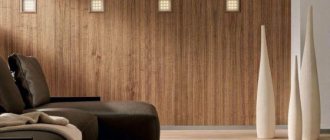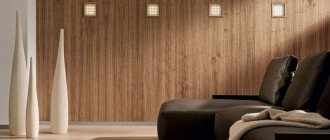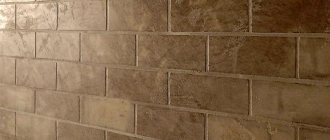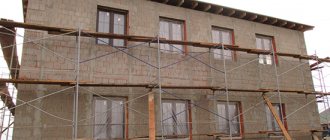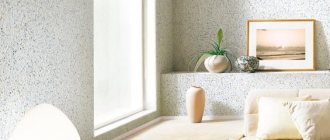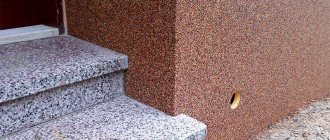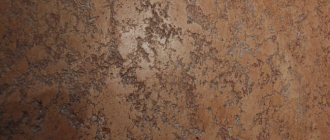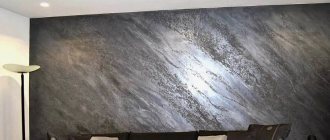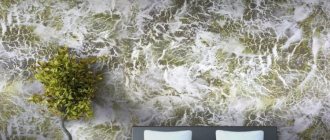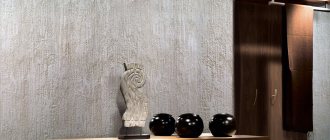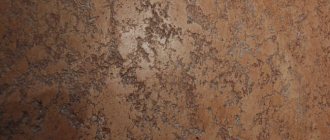Decorative plaster is a rather diverse and interesting material, despite the fact that it is used everywhere. A wall finished with plaster, depending on the type of material, can have a different texture, color, look modest and discreet, or, on the contrary, very expensive. Marble decorative plaster is one of the types of decorative surface finishing. It is used for various purposes, including finishing facades.
Marble decorative plaster
Marble chips
Features of the material
It is not difficult to guess what the filler in marble plaster is. Yes, this is indeed dust and crumbs formed during the processing of marble at mining and processing enterprises of various rocks. The finishing mixture also includes other components, including binders. These can be acrylic-based emulsions, polymer resins, lime, coloring pigments and other additives. Some of them are responsible for giving color to the finishing material, and some are responsible for ensuring that the plaster hardens quickly and adheres well to the surface. There are also those that protect the already applied material from the development of mold, mildew and other “inhabitants” on it - for example, these are antiseptics, as well as water-repellent preparations.
Façade finishing with marble plaster
Colored marble chips for decorative plaster
The history of marble plaster began in ancient times; the material was widely used in Ancient Egypt and Ancient Rome and turned out to be so durable, reliable, high-quality and beautiful that it is used for wall decoration to this day. Only now a person can easily choose the color, texture, quality of the material and exactly the type that will satisfy all his requirements.
On a note! One of the first manufacturers of such plaster on the building materials market was. Therefore, this type of finishing is often called by the name of the company. Thus, marble plaster and bayramix are one and the same.
“Bayramix”, marble plaster photo
Marble chips as a filler have their own characteristics. Firstly, it looks quite stylish and beautiful - the texture of the wall becomes rough. Secondly, the crumb has different adhesion to various substances. Thirdly, this is a fairly durable material for wall decoration.
Marble chips
Coloring the crumbs allows you to make the facade exclusive
On a note! Only marble chips are not always used as a filler for marble plaster. Often the mixture may include granite chips. This type of plaster is called granite-marble plaster.
Marble plaster itself can have different colors, but they are all close to natural stone. However, in reality, the color range of this finishing material is very wide - such plaster is often tinted, which allows it to be used for finishing any surfaces, including facades.
Marble plaster on your walls is real
How much does the work cost?
- The cost of the plaster itself is relatively low - from 100 to 270 rubles. per package. Moreover, the packaging capacity is decent - 30 kg. The problem is usually the need for a thick layer: to finish 1 sq. m. requires from 3 to 5 kg.
- The cost of plastering the surface depends significantly on the required visual effect. The minimum is 400 rubles. for 1 sq. m. However, complicating the processing - applying rust, imitation of complex surfaces, will cost much more.
Stone plaster is one of the most beautiful coatings and is readily used by designers in both classical and modern styles that are not devoid of luxury - high-tech, neo-baroque. However, it also belongs to the category of the most labor-intensive materials.
This video will tell you more about the technique of applying “Stone Flower” plaster:
Advantages and disadvantages
Like any other finishing material, marble plaster has its advantages and disadvantages. It is worth familiarizing yourself with them to decide whether you need to contact this material at all, or whether it is better to use other finishing methods.
Plaster with marble chips - options
The advantages of marble plaster are given below.
- High strength and resistance to mechanical stress, which ensures the durability of the final coating. Although in fairness it is worth noting that plaster based on granite chips is much stronger.
- Large selection of colors and the ability to combine different shades during work.
- Vapor permeability is also high, due to which condensation does not accumulate on the main wall of the house, surfaces can “breathe”.
- Marble plaster is an environmentally friendly material; it does not harm health or the environment.
- This coating is not afraid of ultraviolet radiation, rain, wind, snow. It does not lose its color over time.
- The material can be worked in almost any conditions, and the application technology is quite simple.
- Marble plaster coating is very easy to maintain and easy to clean.
- Mold and fungi do not live on the coating.
Marble plaster of house facade
However, there are also some disadvantages.
- Marble plaster is susceptible to exposure to certain chemicals. In particular, these are acids such as hydrochloric acid.
- The cost of the material is quite high.
Of course, marble plaster has many more advantages than disadvantages. It is not too fancy in its work, and therefore it can really be used for finishing the facade.
Decorative plaster made of colored marble chips
Application technique
The layer of such plaster on the surface for smooth coatings reaches 4–7 mm, and for embossed ones it is even more – 15–25 mm. The plaster is applied in layers, and special techniques and tools are used.
More details about the technique of applying stone plaster are described in this video:
Required Tools
- Spatula - for applying the composition to the surface.
- A grater or grater is used to smooth out the layer.
- Bush hammer - a metal hammer with pyramidal teeth. When struck, the teeth split the plaster and stone grains, which gives the surface a special shine. The blows are delivered with equal force. The bushard is held with both hands.
- Troyanka is a chisel with a tip divided into three parts. Use a Troyanka to chip off the plaster at an angle of 45 degrees.
- Chisel - they can also use a regular one.
Types of marble plaster
The price of plaster depends on many factors. This includes the quality of the raw materials, the promotion of the brand, and the characteristics of the material itself. And the consumption of plaster largely depends on the size of the mineral fractions. Therefore, the total required amount of material and its cost will depend on what kind of plaster the consumer chooses.
White marble plaster
Marble plaster is usually divided into two types - Venetian plaster, which is made from marble flour, and marble plaster itself, which is made from crumbs. The latter is further divided into several varieties depending on the size of the filler fractions, which are:
- 0.5-0.8 mm;
- 0.8-1 mm;
- 1-1.2 mm;
- 1.2-1.4 mm;
- 1.4-2 mm;
- from 5 mm.
Options for marble chips
Table. Material consumption depending on the size of the fractions.
| Inclusion size, mm | Mixture consumption, kg/1 sq. m. |
| 0,5-1 | 1-2,5 |
| 1-2 | 2-3 |
| 2-3 | 4-5 |
| 3 or more | 5-8 |
Filler fractions can also have different shapes. They are faceted or spherical. And the color range is represented mainly by natural shades.
Facade plaster marble chips - known in our country for a very long time
Prices for marble plaster
Marble plaster
How to make a solution for it with your own hands?
Important nuances
The easiest and most correct way is to purchase a ready-made dry mixture and dilute it with water in the required ratio; you won’t need anything else except water and a mixer. In most cases, no water is needed, since the mixture is sold ready-made.
But since the cost of the finished composition is considerable, home craftsmen do not give up trying to make plaster themselves. If it is possible to get stone chips, then this is a completely doable task.
The easiest way is to buy a ready-made dry cement mixture and add stone chips. This will require careful calculations, because the initial version does not involve the inclusion of a rather heavy component.
Recipe
You can use ready-made recipes. So, based on Portland cement no lower than grade M400, the following composition will be obtained:
- marble sand – 74%, with a grain size of up to 2–2.5 mm;
- Portland cement – 5%, white;
- lime dough - 20% of it is prepared by diluting lime with water in a ratio of 3:1 and leaving for a day;
- coloring pigment – manganese peroxide. This is how the colors “gray granite” and “labradorite” are obtained;
- water as needed.
In principle, stone chips can be of any origin: even brick chips are suitable for external finishing work. For the interior, of course, they try to use something more refined.
For example:
- Portland cement – 8%, also white;
- lime dough – 22%;
- ophicalcite crumbs – 60%, granule size up to 2 mm;
- coloring pigment - the same manganese peroxide, chromium oxide.
The technology for plastering facades with stone plasters is discussed below.
Where is it used?
Since marble plaster is an environmentally friendly material, it can be used on any surface - at the final stage of finishing, both to cover the walls of the interior of the house and to decorate the facade. At the same time, it looks discreet, but impressive, stylish, and presentable. It is used to finish concrete and brick, stone and wood, plasterboard and chipboard. It even sticks to water-based paint!
On a note! Using marble plaster, you can decorate columns, balconies, and all kinds of arches very beautifully.
Steps finished with marble plaster
However, such plaster is rarely used in the interior of a living space - the material is too “cold”. But flights of stairs, halls, and corridors decorated with its help will look harmonious. And on the facade, such plaster always looks advantageous.
Decorative plaster TERRACO (mosaic, marble chips)
Stone chips in the exterior
Reviews
- Lyudmila, 32 years old, Moscow: “I have both bathrooms in my house lined with stone plaster. The material is very beautiful, looks like an expensive stone. But installing this coating is very expensive and takes a long time.”
- Olga, 30 years old, Perm: “We decided to use stone plaster for the bathroom and toilet. It looks luxurious, is not afraid of water, and does not accumulate dirt. There have been no changes in 9 years.”
- Alina, 43 years old, Kaspiysk: “It’s beautiful, of course, but the pleasure is expensive. They will tear off both the plaster itself and its installation. On the other hand, it literally lasts forever, so I won’t be in danger of repairs anytime soon.”
- Tatyana, 28 years old, St. Petersburg: “It’s impossible to make stone cladding in an apartment in any way. I was already leaning towards artificial stone, which is lighter, when I accidentally read about stone plaster. I was very pleased with the result: it looks much more natural and interesting than acrylic stone.”
Gypsum plaster stone flower has earned great popularity and positive reviews. How much does stone wool cost for a facade under plaster, crumbs, what is the price of the work - you will learn all this from the next section.
Wall decoration with marble plaster
To apply marble plaster on walls, you do not need to have any special skills. Now all types of this material are quite easy to work with.
Application of marble plaster
You won't need many tools:
- a small basin or bucket in which the mixture will be diluted;
- trowels and trowels for plaster;
- flat brush;
- drill and construction mixer;
- tape, ruler, stepladder, roller for applying primer and other additional materials, which sometimes you can do without.
On a note! Marble plaster should only be applied to a surface that is clean, free of dust and debris, and without visible defects! If there are cracks on the facade, they must be sealed with cement mortar so that the wall becomes smooth. Before applying the plaster mixture, the wall surface is primed (for example, before applying the Bayramix marble plaster to the wall, the manufacturer recommends applying the Astar primer), then you should wait until the primer dries - this is about 24 hours at a temperature not lower than +20 degrees.
Step 1. The finishing material is prepared. The plaster mixture is poured into a clean container, and a little water is added there - about 1 liter per 20 kg.
Dry mixture pours out
Water is added
Step 2. The mixture is thoroughly mixed with a construction mixer at low speed.
Mixing the plaster mixture
Construction mixer price
Construction mixer
Step 3. Plaster is applied to the prepared surface using a trowel and trowel. The plaster is applied to a trowel, and then a uniform layer 1.5-2 crumbs thick is laid on the wall surface. Application is carried out in small areas.
Application of marble plaster
The layer should be 1.5-2 crumbs thick
Step 4. The entire surface of the wall is decorated in the same way.
Plaster is applied to the entire surface
Step 5. After the material has been applied to the wall, it is slightly dried for 15-20 minutes, and then the surface is further smoothed with a metal trowel. The latter should be clean and damp.
Plaster coating after smoothing
Step 6. The surface is well dried during the day. The color of the plaster will appear as the surface dries.
The plaster will take about 24 hours to dry.
Advice! To protect the surface from external influences, a protective mixture can be applied to the dried plaster. The work is done using a roller.
By the way, plaster of different colors can be applied to one wall. Then, during the formation of the pattern, it is necessary to use masking tape, which will also help protect those surfaces where there is no place for plaster from getting the solution. The adhesive tape is glued along the pre-applied markings.
An example of applying plaster of different colors
After the layer of plaster has been applied, you should wait a few minutes (usually about 15) and carefully remove the strip of tape. If two colors of plaster are joined in this way, then the joint line is carefully smoothed with a damp and clean trowel. By the way, to apply plaster of a different color above the joint, you will again have to use a strip of tape. This time it is glued with its edge flush with the edge of the already applied plaster. In the usual way, a mixture of a different color is applied, slightly dried, and then the strip of tape is simply removed.
Removing tape
In this way, you can make various patterns and ornaments on the facade walls. These can be curved lines, squares and circles. In order to get the design, cut out the required shape of the pattern or seal the surface with tape, according to tradition. But if you plan to draw curved lines, then it is better to use patterns. It is worth remembering that the background plaster layer is applied first, and only after it the pattern layer.
Baryte plaster
Used to protect premises from X-ray radiation, a widely used modern alternative to expensive lead screens. Recommended for finishing X-ray rooms, physical laboratories and industrial facilities with hazardous radiation values. Read this article for more details.
Prices for hopper bucket for plaster
Hopper bucket for plaster
Video – Master class on applying marble plaster
What conclusions can be drawn?
- Facade plaster is easy to apply to the wall without using a mounting mesh, because it is light in weight.
- Due to the versatility of the material, it is used not only indoors, but also outdoors.
- Due to the wide selection of shapes, the most suitable texture of the treated surface is selected.
- Stone plaster can be combined with other building materials. It will make the interior of the house original and visually attractive.
- The mixture allows you to fairly level the surface if you apply it in two layers.
- Treating a wall with such a facing material will not take much time and effort.
- By adding cement to the finished mixture, the plaster has excellent characteristics, does not crack, tolerates temperature changes and is not affected by moisture.
Unusual façade design option
Decorating your home with decorative plaster is very easy. To do this, you do not need to have any deep knowledge of construction. It is enough to strictly follow the instructions and carry out the work step by step.
Adviсe
In order for marble plaster to adhere well and the finish to be durable and beautiful, you should follow several rules during the work.
- All work must be carried out in dry, but not hot weather. It is undesirable for the sun's rays to fall on a freshly treated surface.
- Lamps, if there are any on the walls, should not be turned on until the plaster is completely dry.
- The thickness of the plaster layer should not be more than twice the size of one filler crumb.
- Plaster should be applied to one wall continuously to avoid the appearance of unevenness.
- If it is cool outside, then the plaster should be given at least two days to dry completely.
- The drawing is best applied using patterns.
- If coarse marble plaster is used, it can also be applied to rough plaster. But the fine-grained one should be applied to clean putty or a sanded smooth surface.
Marble plaster is a universal method that allows you to hide imperfections in the walls of a building and give them a presentable look.
Prices for different types of plaster floats
Plaster grater
